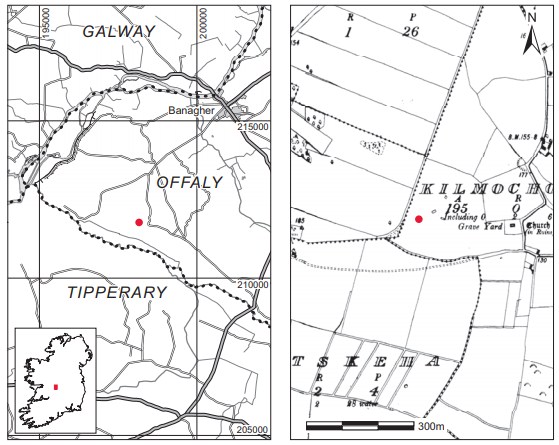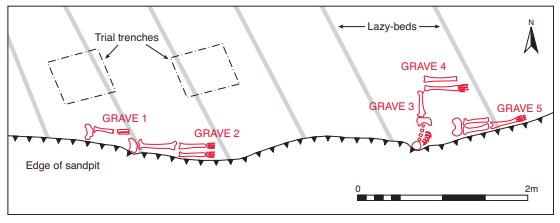County: Offaly Site name: KILMOCHONNA, CO. OFFALY
Sites and Monuments Record No.: SMR OF-029-025 Licence number: E1149
Author: PETER DANAHER
Site type: Graves of indeterminate date
Period/Dating: —
ITM: E 598121m, N 711803m
Latitude, Longitude (decimal degrees): 53.156728, -8.028094
Introduction
In May 1963 a number of human skeletons were discovered during quarrying operations near Lusmagh, Co. Offaly. A skull and some bones were noticed protruding from the upper face of the sandpit. Skeletons had been found here over a few years but these had all been reburied. Work at the sandpit was halted as a result of the discovery, which was reported to the NMI by An Garda Síochána at Banagher, Co. Offaly. A rescue excavation was undertaken by Peter Danaher. The human remains were re-interred in the local cemetery. This report is based on Danaher’s account and plan of the site.
In 1997 burials were discovered in the same quarry in the adjoining townland of Newtown.82 The site was visited by Mary Cahill on behalf of the NMI and, later, by Dr Elizabeth O’Brien on behalf of the National Monuments Service. On this occasion the site was not excavated, as this area was not due to be disturbed any further by Banagher Concrete. Disturbed human bone was collected from the quarry floor, however, and a loose bone from an undisturbed burial in the bank was also removed (1997:48).
Location (Fig. 6.49)
The site was in the townland of Kilmochonna in west County Offaly, close to the border with counties Galway and Tipperary.83 It was located on a gravel ridge running south-west/northeast at an altitude of 40–50m above sea level. Kilmochonna church and graveyard are some 500m west of the site.84


Site stratigraphy and excavation methodology
Bones were visible in the face of the pit approximately 0.5m below the surface. Lazy-beds had been dug across the ridge in a north-west/south-east direction, and it was evident from surface indications that these post-dated the burial of the bodies. Trial trenches were dug across the lazy-beds a few metres back from the edge of the sandpit.
Description of site
The remains of five incomplete skeletons were discovered, all lying on a vein of fine sand approximately 0.5m under a gravel-rich clay layer. No other features were noted and they were presumably simple dug graves without any stone protection (Fig. 6.50).
Four of the skeletons were aligned west/east, while the fifth lay in a south/north direction with the feet to the north. All lay in a supine position and, from what remained, appeared to be extended. Graves 1 and 2 lay side by side approximately 4m from graves 3, 4 and 5, which were in close proximity to each other.
Grave 1
One half of this skeleton had collapsed over the edge of the sandpit. The body lay in a supine position with the head to the west and the feet to the east. The lower jawbone and teeth were present but no skull (probably owing to the furrow at this point), and only the left ribs, pelvis, femur, tibia and fibula remained. This was thought by the excavator to be the remains of a child.
Grave 2
According to Danaher, this was an adult skeleton. It lay beside grave 1, with the head probably opposite the pelvis of skeleton 1. The body lay in a supine position with the head to the west and the feet to the east. The remains consisted of the left part of the pelvis, femur, tibia and foot bones (the right tibia and foot bones); the rest had presumably collapsed over the edge of the pit.
Grave 3
This was identified by Danaher as an adult skeleton. It was located immediately underneath skeleton 4. It lay in a supine position with the head to the north. The remains consisted of skull, ribs, pelvis and right femur.
Grave 4
Danaher identified this as the remains of an adult skeleton. It lay in a supine position with the head to the west and the feet to the east. The remains consisted of both tibiae and the feet bones.
Grave 5
According to Danaher the remains were those of an adult skeleton. It lay in a supine position with the head to the west and the feet to the east. The remains consisted of pelvis, both femora and a tibia.
Comment
In her report for the National Monuments Service, Dr O’Brien commented that it is likely that the ruined medieval church is the site of an ancient foundation. St Mochonna, possibly of Lusmag (Mochonna m. Lusmaige), is recorded in the lists of Irish saints in Corpus genealogiarum sanctorum Hiberniae (Ó Riain 1985, 149). O’Brien considers that this site may represent ‘a secular “ancestral” cemetery which lay outside the church boundaries’.
82. IGR 11988 22113.
83. Parish of Lusmagh, barony of Garrycastle. SMR OF-029-025——. IGR 198170 211772.
84. SMR OF029-012—-.